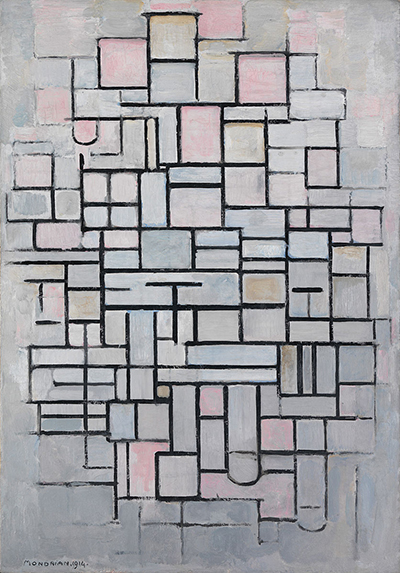Piet Mondrian moved to Paris in 1912 and this would bring about a major shift in his work. Composition No.IV / Composition 6 is displayed here at this piece arrived just two years later as the artist engulfed himself in abstract art techniques.
In front of us here with this painting we immediately see a mosaic of rectangles, seemingly arranged in a natural, organic manner. The lines which define shape are thick black touches of black paint, all at right angles to the edge of the canvas. Mondrian did not want curves or diagonals at this stage, and this ensured a consistent look to his paintings even though there was a strong variety in the sizes of these small panels. They almost resemble a patio, but without any items lining up with each other. There are also some lines which do not create independent shapes, but actually just cut off in the middle. Mondrian would continue to use grids for many years, but the style of it here is entirely unstructured. Mondrian would the fill some of the forms between these lines in with colour, as well as softening the lines on the edges of the painting so that the main content slowly fades away. He chooses muted tones which avoid contrasting too much from the grey background and the black lines, whilst still bringing some aesthetic interest to the overall piece. The artist would produce several similar works in the year of 1914, including Composition 8.
Mondrian is regarded as one of the most influential Dutch artists of all time which is quite a claim considering the amount of artists who have come from this highly cultured nation. Indeed the Netherlands has been involved in most major periods of European art since the Middle Ages and there seems no sign of that ending anytime soon. The high status of several art galleries and museums within the country should also help to keep this cycle continuing, whilst also helping to give Dutch people a huge pride in the cultural achievements that were made by their country in previous centuries. One can also point to the advancements in technique, such as with oil painting and also the etching mastery which occured in this region.
Composition No.IV / Composition 6 is to be found within the permanent collection of the Kunstmuseum in The Hague, Netherlands. They do not give out too much information on the piece unfortunately, but do reveal its size to be a height of 88.0 cm and a width of 61.0 cm. They also confirm its date at 1914 and suggest that they received the piece as a bequethed item from Dutchman, Salomon B. Slijper. They have a number of highlights within their collection including many modern art ceramics and paintings. Expressionists can be found here too, including a number of notable German painters such as August Macke and Egon Schiele. They therefore have concentrated on contemporary art, with many other major Dutch galleries able to cover art from the centuries previous to that. Mondrian is therefore a highly suitable addition to this museum and they have several other items from his career included within this gallery.




